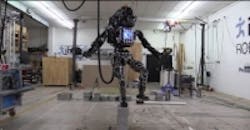ATLAS, the humanoid robot with functioning limbs and hands, recently received from programming updates via a new algorithm from the Florida Institute for Human and Machine Cognition (IHMC), which enables it to walk like a human with more agility and control than ever before.
MORE ARTICLES
Google and the robot revolution
Google’s Schaft humanoid robot wins DARPA Robotics Challenge
DARPA Robotics Challenge trials to test robots in disaster response operations
Built by the Google-owned Boston Dynamics, with funding and oversight from the United States Defense Advanced Research Projects Agency (DARPA), the robot features a head-mounted MultiSense-SL 3D data sensor package, which is comprised of a Hokuyo UTM-30LX-EW laser and a Carnegie Robotics MultiSense S7 stereo camera. The camera is fitted with either a 2 MPixel CMV2000 or 4 MPixel CMV4000 CMOS image sensor from CMOSIS. These sensors feature a Bayer color filter array and achieve a maximum frame rate of 30 fps.
MultiSense SL also features on-board processing for image rectification, stereo data processing, time synchronizing of laser data with a spindle encoder, spindle motor control, lighting timing, and managing the GigE interface. It also features an on-board real time control computer, and near human anthropometry with 28 hydraulically-actuated joints. The new algorithm developed by IHMC enables ATLAS to walk more like a human, and with more balance. IHMC recently had some success in DARPA’s Robotics Challenge, coming first in computer simulations and second in real-life field trials.
The ATLAS robot has four hydraulically-actuated limbs, blue LED illumination, and is made of aircraft-grade aluminum and titanium. Standing at 6 feet tall and weighing 330 pounds, the robot was designed for a variety of search and rescue missions. During DARPA’s Robotics Challenge, ATLAS “shell” robots (robots without a “brain”), were provided to six teams to test the robot's ability to perform various tasks, including getting in and out of a vehicle and driving it, opening a door, and using a power tool. The contest was inspired by the 2011 Fukushima Daiichi nuclear disaster, which represents a possible future scenario in which the ATLAS robot could be used
View an IHMC release.
View more information on ATLAS.
View more information on the MultiSense-SL.
Share your vision-related news by contacting James Carroll, Senior Web Editor, Vision Systems Design
To receive news like this in your inbox, click here.
Join our LinkedIn group | Like us on Facebook | Follow us on Twitter | Check us out on Google +
About the Author

James Carroll
Former VSD Editor James Carroll joined the team 2013. Carroll covered machine vision and imaging from numerous angles, including application stories, industry news, market updates, and new products. In addition to writing and editing articles, Carroll managed the Innovators Awards program and webcasts.
